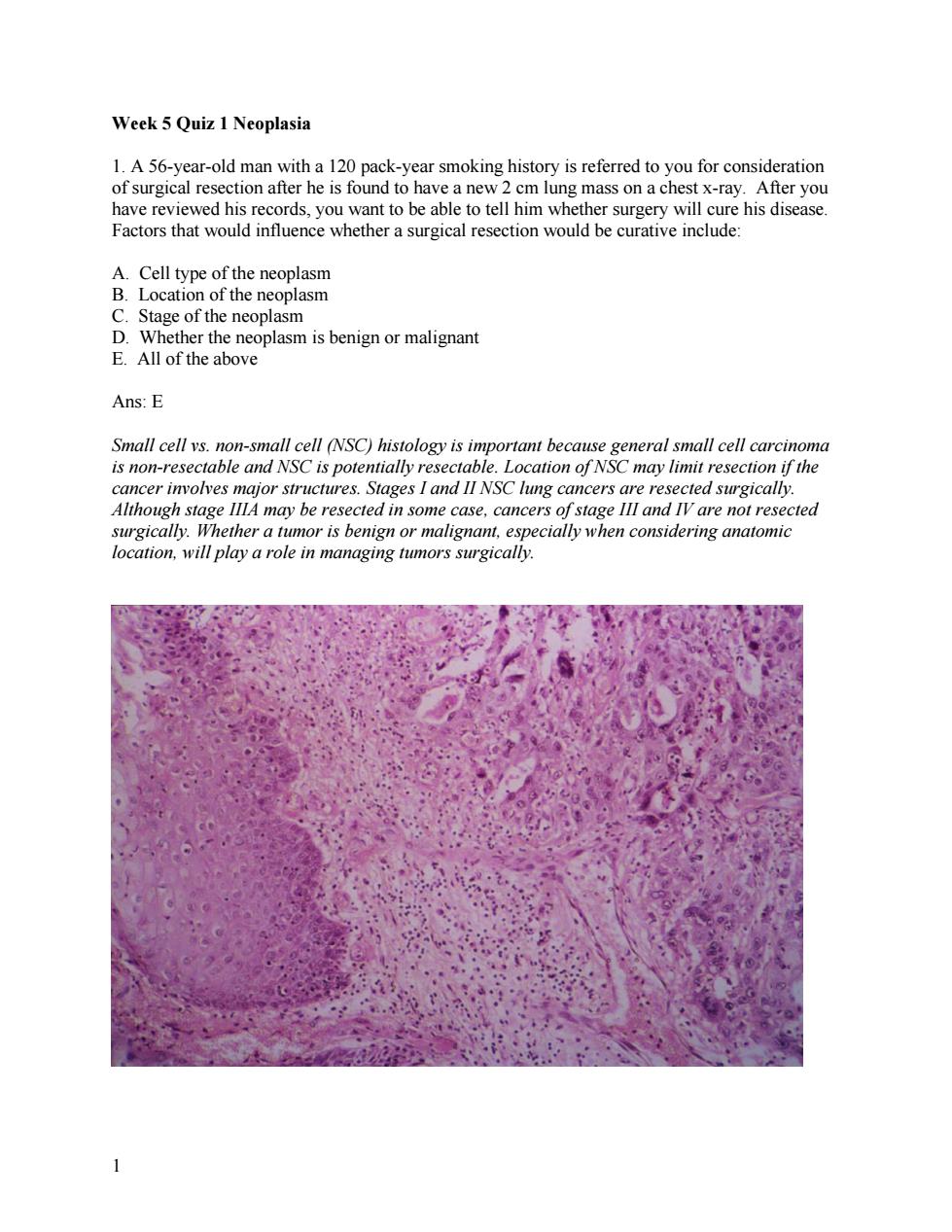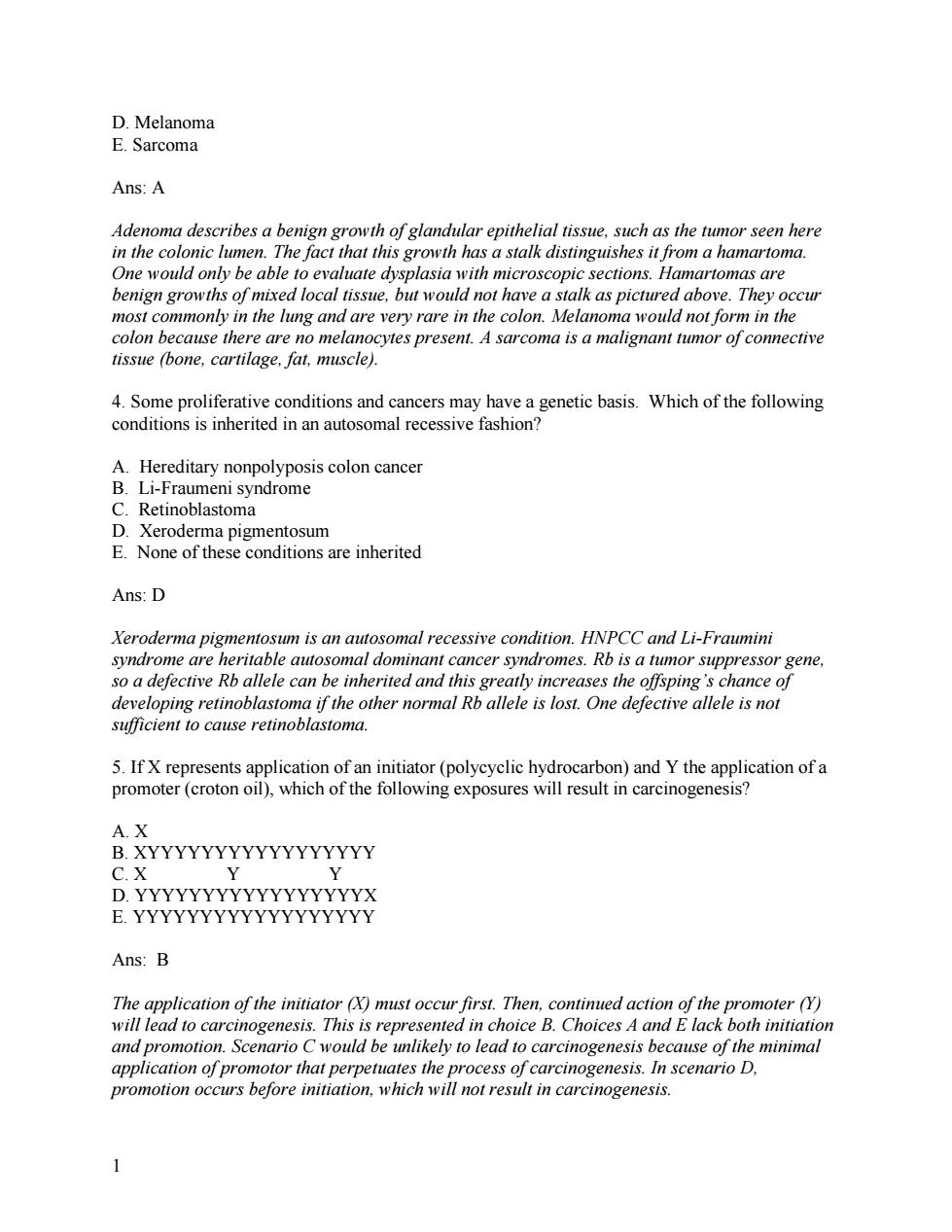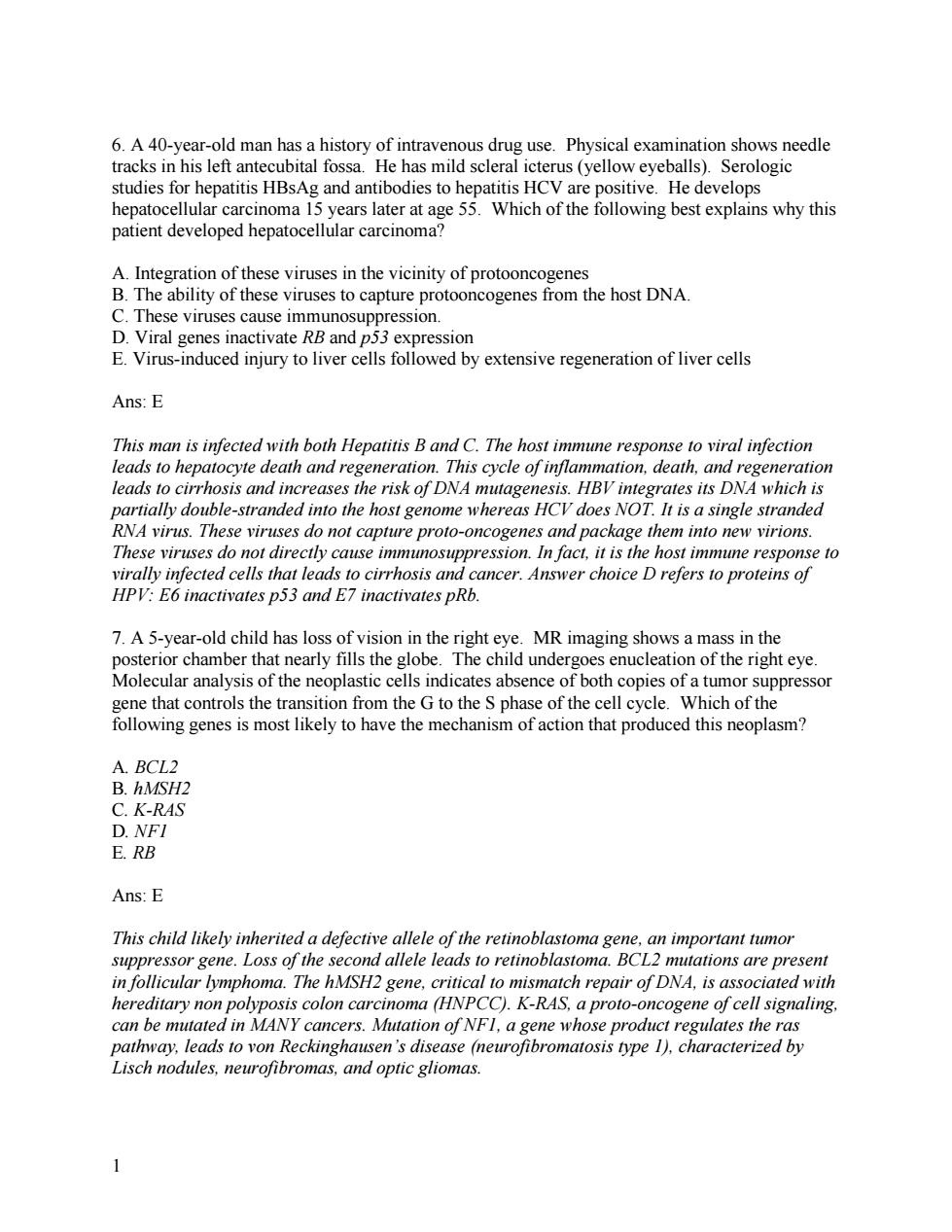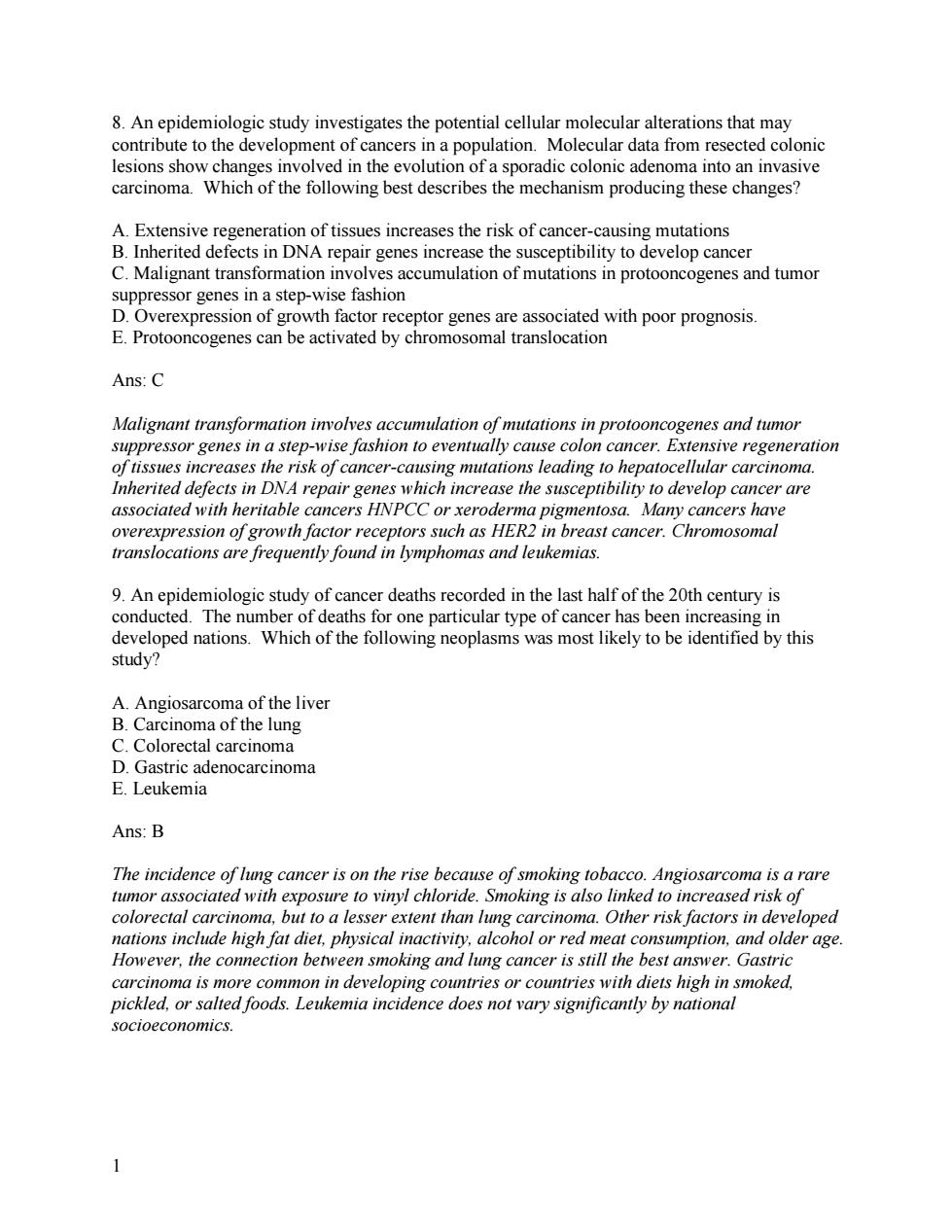
Week 5 Quiz 1 Neoplasia 1.A 56-year-old man with a 120 pack-year smoking history is referred to you for consideration of surgical resection after he is found to have a new 2 cm lung mass on a chest x-ray.After you have reviewed his records,you want to be able to tell him whether surgery will cure his disease. Factors that would influence whether a surgical resection would be curative include: A.Cell type of the neoplasm B.Location of the neoplasm C.Stage of the neoplasm D.Whether the neoplasm is benign or malignant E.All of the above Ans:E is non-resec mnd NSC is h cted surgically h is benign or malignant,especially when considering anatomic location,will play a role in managing tumors surgically
1 Week 5 Quiz 1 Neoplasia 1. A 56-year-old man with a 120 pack-year smoking history is referred to you for consideration of surgical resection after he is found to have a new 2 cm lung mass on a chest x-ray. After you have reviewed his records, you want to be able to tell him whether surgery will cure his disease. Factors that would influence whether a surgical resection would be curative include: A. Cell type of the neoplasm B. Location of the neoplasm C. Stage of the neoplasm D. Whether the neoplasm is benign or malignant E. All of the above Ans: E Small cell vs. non-small cell (NSC) histology is important because general small cell carcinoma is non-resectable and NSC is potentially resectable. Location of NSC may limit resection if the cancer involves major structures. Stages I and II NSC lung cancers are resected surgically. Although stage IIIA may be resected in some case, cancers of stage III and IV are not resected surgically. Whether a tumor is benign or malignant, especially when considering anatomic location, will play a role in managing tumors surgically

2.A 67-year-old man has noted a chronic cough for the past 3 months.On physical examination there is a mild stridor on inspiration over the right lung.A chest radiograph shows a 5 cm right hilar lung mass.No other abnormalities are seen on chest CT.Additional studies are done and the staging of this neoplasm is denoted as T2NIMI.Based only on the information provided, which of the following statements is most accurate? A.a cT scan of the brain shows metastasis B.Serum chemistry shows an elevated corticotrophin level. C.The cancer is poorly differentiated. rated the diaphragm mor is obstructing the left ma stem bronchus Ans:A Metastatic tumor at the time of presentation is a poor prognostic indi ator.Thus imaging studies are conducted to determine whe her or the tumor has metastasized.MI denotes metastasis.Some ung tumors can produce ACTH.but this vignette does not provide any indication ofelevated levels of cortisol.Determination of grade requires histologic examination of multiple sections of tumor.Infiltration of the diaphragm is unlikely.since the mass is in the hilar region.Obstruction of the left mainstem bronchus would be visible on CT scan,but there is no specific information to support this answer choice. 可gm 3.During a routine health maintenance examination of a 40-year-old man a stool guaiac test result was positive (occult blood in the stool).A follow-up sigmoidoscopy showed a 1.5 cm circumscribed,pedunculated mass on a short stalk,located in the upper rectum.Which of the following terms best describes the lesion? A.Adenoma B Dysplasia C.Hamartoma
1 2. A 67-year-old man has noted a chronic cough for the past 3 months. On physical examination there is a mild stridor on inspiration over the right lung. A chest radiograph shows a 5 cm right hilar lung mass. No other abnormalities are seen on chest CT. Additional studies are done and the staging of this neoplasm is denoted as T2N1M1. Based only on the information provided, which of the following statements is most accurate? A. A CT scan of the brain shows metastasis. B. Serum chemistry shows an elevated corticotrophin level. C. The cancer is poorly differentiated. D. The mass had infiltrated the diaphragm. E. The tumor is obstructing the left mainstem bronchus. Ans: A Metastatic tumor at the time of presentation is a poor prognostic indicator. Thus imaging studies are conducted to determine whether or the tumor has metastasized. M1 denotes metastasis. Some lung tumors can produce ACTH, but this vignette does not provide any indication of elevated levels of cortisol. Determination of grade requires histologic examination of multiple sections of tumor. Infiltration of the diaphragm is unlikely, since the mass is in the hilar region. Obstruction of the left mainstem bronchus would be visible on CT scan, but there is no specific information to support this answer choice. 3. During a routine health maintenance examination of a 40-year-old man a stool guaiac test result was positive (occult blood in the stool). A follow-up sigmoidoscopy showed a 1.5 cm circumscribed, pedunculated mass on a short stalk, located in the upper rectum. Which of the following terms best describes the lesion? A. Adenoma B. Dysplasia C. Hamartoma

D.Melanoma E.Sarcoma Ans:A Adenoma describes a benign growth of glandular epithelial tissue,such as the tumor seen here in the colonic lumen.The fact that this growth has a stalk distinguishes it from a hamartoma. One would only be able to evaluate dysplasia with microscopic sections.Hamartomas are benign growths of mixed local tissue,but would not have a stalk as pictured above.They occur most commonly in the lung and are very rare in the colon.Melanoma would not form in the colon because there are no melanocytes present.A sarcoma is a malignant tumor of connective tissue (bone,cartilage,fat,muscle). 4.cancers may basis.Which of the following condit rited in an autosomal recessive fashion? lyposis colon cancer umeni syndrome Retinoblastoma Xeroderma pigmentosum Ans:D Xeroderma pigmentosum is an autosomal recessive condition.HNPCC and Li-Fraumini syndrome are heritable autosomal dominant cancer syndromes.Rb is a tumor suppressor gene, so a defective Rb allele can be inherited and this greatly increases the offsping's chance of developing retinoblastoma if the other normal Rb allele is lost.One defective allele is not sufficient to cause retinoblastoma. 5.If X represents application of an initiator(polycyclic hydrocarbon)and Y the application of a promoter(croton o il)which of the follov exp sures will result in carcinoge sis? E.YYYYYYYYYYYYYYYYYY Ans:B The application of the initiator X)must occur first.Then,continued action of the promoter (Y) will lead to carcinogenesis.This is represented in choice B.Choices A and E lack both initiation and promotion.Scenario Cwould be unlikely to lead to carcinogenesis because of the minimal application of promotor that perpetuates the process of carcinogenesis.In scenario D. promotion occurs before initiation,which will not result in carcinogenesis. 1
1 D. Melanoma E. Sarcoma Ans: A Adenoma describes a benign growth of glandular epithelial tissue, such as the tumor seen here in the colonic lumen. The fact that this growth has a stalk distinguishes it from a hamartoma. One would only be able to evaluate dysplasia with microscopic sections. Hamartomas are benign growths of mixed local tissue, but would not have a stalk as pictured above. They occur most commonly in the lung and are very rare in the colon. Melanoma would not form in the colon because there are no melanocytes present. A sarcoma is a malignant tumor of connective tissue (bone, cartilage, fat, muscle). 4. Some proliferative conditions and cancers may have a genetic basis. Which of the following conditions is inherited in an autosomal recessive fashion? A. Hereditary nonpolyposis colon cancer B. Li-Fraumeni syndrome C. Retinoblastoma D. Xeroderma pigmentosum E. None of these conditions are inherited Ans: D Xeroderma pigmentosum is an autosomal recessive condition. HNPCC and Li-Fraumini syndrome are heritable autosomal dominant cancer syndromes. Rb is a tumor suppressor gene, so a defective Rb allele can be inherited and this greatly increases the offsping’s chance of developing retinoblastoma if the other normal Rb allele is lost. One defective allele is not sufficient to cause retinoblastoma. 5. If X represents application of an initiator (polycyclic hydrocarbon) and Y the application of a promoter (croton oil), which of the following exposures will result in carcinogenesis? A. X B. XYYYYYYYYYYYYYYYYY C. X Y Y D. YYYYYYYYYYYYYYYYYX E. YYYYYYYYYYYYYYYYYY Ans: B The application of the initiator (X) must occur first. Then, continued action of the promoter (Y) will lead to carcinogenesis. This is represented in choice B. Choices A and E lack both initiation and promotion. Scenario C would be unlikely to lead to carcinogenesis because of the minimal application of promotor that perpetuates the process of carcinogenesis. In scenario D, promotion occurs before initiation, which will not result in carcinogenesis

6.A 40-year-old man has a history of intravenous drug use.Physical examination shows needle tracks in his left antecubital fossa.He has mild scleral icterus(yellow eyeballs).Serologic studies for hepatitis HBsAg and antibodies to hepatitis HCV are positive.He develops hepatocellular carcinoma 15 years later at age 55.Which of the following best explains why this patient developed hepatocellular carcinoma? A.Integration of these viruses in the vicinity of protooncogenes B.The ability of these viruses to capture protooncogenes from the host DNA. C These vin D Vira vate RR nd ed injury to liver cells foli d by extensive regeneration of liver cells Ans:E This man is infected with both Hepatitis B and C.The host immune response to viral infection leads to hepatocyte death and regeneration.This cycle of inflammation.death,and regeneration leads to cirrhosis and increases the risk of DNA mutagenesis.HBV integrates its DNA which is partially double-stranded into the host genome whereas HCV does NOT.It is a single stranded RNA virus.These viruses do not capture proto-oncogenes and package them into new virions. These viruses do not directly cause immunosuppression.In fact,it is the host immune response to virally infected cells that leads to cirrhosis and cancer.Answer choice D refers to proteins of HPV:E6 inactivates p53 and E7 inactivates pRb. 7.A 5-year-old child has loss of vision in the right eye.MR imaging shows a mass in the posterior chamber that nearly fills the globe.The child undergoes enucleation of the right eye. Mofthe e ces indicates absen of both cooftumor suppreso he that controls the transition from the G to the S phase of the cell c cle.Which of the nost likely to he me of action that pro duced this sm? C K-RAS Ans:E This child likely inherited a defective allele of the retinoblastoma gene,an important tumor suppressor gene.Loss of the second allele leads to retinoblastoma.BCL2 mutations are present in follicular lymphoma.The hMSH2 gene,critical to mismatch repair of DNA,is associated with hereditary non polyposis colon carcinoma (HNPCC).K-RAS,a proto-oncogene of cell signaling. can be mutated in MANY cancers.Mutation of NFI,a gene whose product regulates the ras pathway,leads to von Reckinghausen's disease (neurofibromatosis type 1),characterized by Lisch nodules,neurofibromas,and optic gliomas
1 6. A 40-year-old man has a history of intravenous drug use. Physical examination shows needle tracks in his left antecubital fossa. He has mild scleral icterus (yellow eyeballs). Serologic studies for hepatitis HBsAg and antibodies to hepatitis HCV are positive. He develops hepatocellular carcinoma 15 years later at age 55. Which of the following best explains why this patient developed hepatocellular carcinoma? A. Integration of these viruses in the vicinity of protooncogenes B. The ability of these viruses to capture protooncogenes from the host DNA. C. These viruses cause immunosuppression. D. Viral genes inactivate RB and p53 expression E. Virus-induced injury to liver cells followed by extensive regeneration of liver cells Ans: E This man is infected with both Hepatitis B and C. The host immune response to viral infection leads to hepatocyte death and regeneration. This cycle of inflammation, death, and regeneration leads to cirrhosis and increases the risk of DNA mutagenesis. HBV integrates its DNA which is partially double-stranded into the host genome whereas HCV does NOT. It is a single stranded RNA virus. These viruses do not capture proto-oncogenes and package them into new virions. These viruses do not directly cause immunosuppression. In fact, it is the host immune response to virally infected cells that leads to cirrhosis and cancer. Answer choice D refers to proteins of HPV: E6 inactivates p53 and E7 inactivates pRb. 7. A 5-year-old child has loss of vision in the right eye. MR imaging shows a mass in the posterior chamber that nearly fills the globe. The child undergoes enucleation of the right eye. Molecular analysis of the neoplastic cells indicates absence of both copies of a tumor suppressor gene that controls the transition from the G to the S phase of the cell cycle. Which of the following genes is most likely to have the mechanism of action that produced this neoplasm? A. BCL2 B. hMSH2 C. K-RAS D. NF1 E. RB Ans: E This child likely inherited a defective allele of the retinoblastoma gene, an important tumor suppressor gene. Loss of the second allele leads to retinoblastoma. BCL2 mutations are present in follicular lymphoma. The hMSH2 gene, critical to mismatch repair of DNA, is associated with hereditary non polyposis colon carcinoma (HNPCC). K-RAS, a proto-oncogene of cell signaling, can be mutated in MANY cancers. Mutation of NF1, a gene whose product regulates the ras pathway, leads to von Reckinghausen’s disease (neurofibromatosis type 1), characterized by Lisch nodules, neurofibromas, and optic gliomas

8.An epidemiologic study investigates the potential cellular molecular alterations that may contribute to the development of cancers in a population.Molecular data from resected colonic lesions show changes involved in the evolution of a sporadic colonic adenoma into an invasive carcinoma.Which of the following best describes the mechanism producing these changes? A.Extensive regeneration of tissues increases the risk of cancer-causing mutations B.Inherited defects in DNA repair genes increase the susceptibility to develop cancer C.Malignant transformation involves accumulation of mutations in protooncogenes and tumor suppressor genes in a step-wise fashion D.Overexpression of growth factor receptor genes are associated with poor prognosis. E.Protooncogenes can be activated by chromosomal translocation Ans:C Malignant transformation inv of mutations in protooncogenes and tmor suppresso gene o canc ar carcinom red defe repair gen which increase the susceptib ry to evelop cancer ar 22singorhacorecepiorsschas9HER2Wgema associated with ritable cancers HNPCC or xero cancers hav n breast cancer.Chromosoma franslocations are frequently found in lymphomas and leukemias. 9.An epidemiologic study of cancer deaths recorded in the last half of the 20th century is conducted.The number of deaths for one particular type of cancer has been increasing in developed nations.Which of the following neoplasms was most likely to be identified by this study? A.Angiosarcoma of the liver B.Carcinoma of the lung C.Colorectal carcinoma D.Gastric adenocarcinoma E Leukemia Ans:B use of smoki de- moking is also is a rare mg carcinoma.Other risk factors in lopec nations inc However.the connection between smoking and lung cancer is still the best ans er. carcinoma is more common in developing countries or countries with diets high in smoked. pickled,or salted foods.Leukemia incidence does not vary significantly by national socioeconomics
1 8. An epidemiologic study investigates the potential cellular molecular alterations that may contribute to the development of cancers in a population. Molecular data from resected colonic lesions show changes involved in the evolution of a sporadic colonic adenoma into an invasive carcinoma. Which of the following best describes the mechanism producing these changes? A. Extensive regeneration of tissues increases the risk of cancer-causing mutations B. Inherited defects in DNA repair genes increase the susceptibility to develop cancer C. Malignant transformation involves accumulation of mutations in protooncogenes and tumor suppressor genes in a step-wise fashion D. Overexpression of growth factor receptor genes are associated with poor prognosis. E. Protooncogenes can be activated by chromosomal translocation Ans: C Malignant transformation involves accumulation of mutations in protooncogenes and tumor suppressor genes in a step-wise fashion to eventually cause colon cancer. Extensive regeneration of tissues increases the risk of cancer-causing mutations leading to hepatocellular carcinoma. Inherited defects in DNA repair genes which increase the susceptibility to develop cancer are associated with heritable cancers HNPCC or xeroderma pigmentosa. Many cancers have overexpression of growth factor receptors such as HER2 in breast cancer. Chromosomal translocations are frequently found in lymphomas and leukemias. 9. An epidemiologic study of cancer deaths recorded in the last half of the 20th century is conducted. The number of deaths for one particular type of cancer has been increasing in developed nations. Which of the following neoplasms was most likely to be identified by this study? A. Angiosarcoma of the liver B. Carcinoma of the lung C. Colorectal carcinoma D. Gastric adenocarcinoma E. Leukemia Ans: B The incidence of lung cancer is on the rise because of smoking tobacco. Angiosarcoma is a rare tumor associated with exposure to vinyl chloride. Smoking is also linked to increased risk of colorectal carcinoma, but to a lesser extent than lung carcinoma. Other risk factors in developed nations include high fat diet, physical inactivity, alcohol or red meat consumption, and older age. However, the connection between smoking and lung cancer is still the best answer. Gastric carcinoma is more common in developing countries or countries with diets high in smoked, pickled, or salted foods. Leukemia incidence does not vary significantly by national socioeconomics

10.A 35-year-old man with a family history of colon carcinoma undergoes a surveillance colonoscopy.It reveals hundreds of polyps in the colon and two focal 0.5 cm ulcerated areas.A biopsy from an ulcer is shown above and reveals irregularly shaped glands that have penetrated into the muscular layer.Which of the following molecular events is believed to occur very early in the evolution of his colonic disease process? A.Activated tumor suppressor genes B.Amplified HER2/neu C Heter Sp53 D.Inhe E.Trans om mitochondria to cytoplasm Ans:C The scenario describes a man with familial adenomatous polyposis.One of the early mutations is likely to be a loss of one allele of the p53 gene,an event associated with the transition from adenoma to carcinoma.Activation of tumor suppressor genes would reduce the likelihood of tumorigenesis.Amplification of HER2/neu (growth factor receptors)is a process implicated in many breast cancers.An inherited APC germline mutation cannot be an early molecular event in the evolution of this disease process.because the inherited copy was already there at the outset. Bcl2 blocks the insertion of a pore into the mitochondrial membrane,which would allow for release of cytochrome c and activation of apoptotic caspases.Thus bel2 is anti-apoptotic;it is associated with lymphoma but mutations are found in many cancers. 11 a clinical study involves patients diagnosed with carcinoma and whose tumor stage is T4NIMI.The patients' rate 5 years from the time of diagnosis is less than 50% egardless of the Which of the follo ing c linical findings is most likely to be characteristic of this group of p tients? A.Cache BC Cardiac murmu D.Loss of sensation
1 10. A 35-year-old man with a family history of colon carcinoma undergoes a surveillance colonoscopy. It reveals hundreds of polyps in the colon and two focal 0.5 cm ulcerated areas. A biopsy from an ulcer is shown above and reveals irregularly shaped glands that have penetrated into the muscular layer. Which of the following molecular events is believed to occur very early in the evolution of his colonic disease process? A. Activated tumor suppressor genes B. Amplified HER2/neu C. Heterozygous p53 gene D. Inherited APC germline mutation E. Translocation of BCL2 from mitochondria to cytoplasm Ans: C The scenario describes a man with familial adenomatous polyposis. One of the early mutations is likely to be a loss of one allele of the p53 gene, an event associated with the transition from adenoma to carcinoma. Activation of tumor suppressor genes would reduce the likelihood of tumorigenesis. Amplification of HER2/neu (growth factor receptors) is a process implicated in many breast cancers. An inherited APC germline mutation cannot be an early molecular event in the evolution of this disease process, because the inherited copy was already there at the outset. Bcl2 blocks the insertion of a pore into the mitochondrial membrane, which would allow for release of cytochrome c and activation of apoptotic caspases. Thus bcl2 is anti-apoptotic; it is associated with lymphoma but mutations are found in many cancers. 11. A clinical study involves patients diagnosed with carcinoma and whose tumor stage is T4N1M1. The patients’ survival rate 5 years from the time of diagnosis is less than 50%, regardless of therapy. Which of the following clinical findings is most likely to be characteristic of this group of patients? A. Cachexia B. Cardiac murmur C. Icterus D. Loss of sensation

E.Splenomegaly Ans:A Cachexia is common finding in advanced cancer and weight loss without dieting in an adult is a "red flag"for malignancy.The exact cause for this is unknown,but increases in circulating substances such as tumor necrosis factor may play a role.Cardiac murmurs may occur in the development of nonbacterial thrombotic endocarditis,a feature of hypercoagulable states that may occur in advanced malignancy.Icterus is most likely to occur when there is obstruction of the biliary tract by a mass such as pancreatic cancer.Metastasis are unlikely to cause obstruction.Neurologic abnormalities may occur with local tumor growth impinging on nerves. but dull constant pain is more likely as malignant cells invade nerves.Metastasis to the spleen are uncommon. 12.A52- mination he ha mn has had increasing the past 6 months.On physical exa a palpa periphera ratory st show a 18900 any ma a ne marrow aspir (922) tion to be present.This tra gene th t greatly increas s tyrosine kinase activity.Which of the following genes is most likely translocated to cause these findings? A.ABL B.NF-I C.p53 D.RAS E RB Ans:A This man probably has chromic mvelongenous leukemia.which is associated with a t(9:22) translocation which creates a hybrid BRC-ABL gene (located on chromosome 22.called the Philadelphia chromoso e)The ty activity of ABL is up gulated.leading to increased cell division.The other nes are not as、 ated with tr .NE-I I P53 and Ras mutations are common to many cancers s.Rb mutations are implicated in renn
1 E. Splenomegaly Ans: A Cachexia is common finding in advanced cancer and weight loss without dieting in an adult is a “red flag” for malignancy. The exact cause for this is unknown, but increases in circulating substances such as tumor necrosis factor may play a role. Cardiac murmurs may occur in the development of nonbacterial thrombotic endocarditis, a feature of hypercoagulable states that may occur in advanced malignancy. Icterus is most likely to occur when there is obstruction of the biliary tract by a mass such as pancreatic cancer. Metastasis are unlikely to cause obstruction. Neurologic abnormalities may occur with local tumor growth impinging on nerves, but dull constant pain is more likely as malignant cells invade nerves. Metastasis to the spleen are uncommon. 12. A 52-year-old man has had increasing fatigue for the past 6 months. On physical examination he has a palpable spleen tip. Laboratory studies show a WBC count of 189,000/microliter. The peripheral blood smear shows many mature and immature myeloid cells present. Cytogenetic analysis of cells obtained via bone marrow aspiration reveals a t (9:22) translocation to be present. This translocation leads to formation of a hybrid gene that greatly increases tyrosine kinase activity. Which of the following genes is most likely translocated to cause these findings? A. ABL B. NF-1 C. p53 D. RAS E. RB Ans: A This man probably has chromic myelongenous leukemia, which is associated with a t(9;22) translocation which creates a hybrid BRC-ABL gene (located on chromosome 22, called the Philadelphia chromosome). The tyrosine kinase activity of ABL is up-regulated, leading to increased cell division. The other genes are not associated with translocations or with hematologic malignancies. NF-1 causes neurofibromatosis type 1. P53 and Ras mutations are common to many cancers. Rb mutations are implicated in retinoblastoma